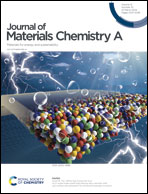Self-assembled metal-oxo clusters for sensitive and low-powered ultraviolet photodetectors†
Abstract
Despite their wide-bandgap nature and ultrahigh stability under high-energy UV radiation, zirconium-oxo clusters (ZOCs) have not yet been studied for applications related to ultraviolet (UV) detection. Interestingly, individual ZOCs can be self-assembled by bridging inter-cluster linkers to yield large-dimensional flakes with a notably low defect-induced trap density. Trap reduction facilitates efficient photon-generated charge transfer within the ZOC flakes compared with traditional UV-sensitive materials based on metal oxides or metal nitrides. In this paper, we propose a facile strategy for applying self-assembled ZOC square flakes to deep-UV photodetectors. Combined with a reasonable amount of highly transparent polyethylenimine (PEI) polymer, an asymmetrical metal–semiconductor–metal (MSM) device based on the ZOC@PEI composite film exhibited an excellent UVC photoresponse with a detectivity of 1.91 × 1012 Jones and an external quantum efficiency of 125%. This work, for the first time, demonstrates the considerable potential of utilizing ZOCs as an efficient photoactive component in highly sensitive and low-powered UV photodetectors.



 Please wait while we load your content...
Please wait while we load your content...